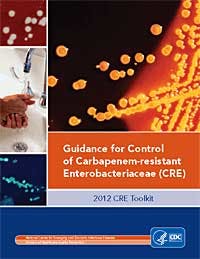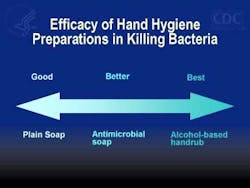The bacteria, known as Carbapenem-Resistant Enterobacteriaceae (CRE), are named for their ability to fight off carbapenem antibiotics, the last line of defense in the medical toolbox. And so far, they've emerged almost exclusively in health care facilities, attacking the weakest of patients. Several resistance mechanisms are responsible for highly antibiotic-resistant Gram-negative bacilli, such as CRE. Klebsiella pneumoniae carbapenemase (KPC) is currently the most common resistance mechanism causing CRE in the United States.(1) In light of the clinical and infection control challenges posed by CRE and advances in the ability to detect these pathogens, CDC and HICPAC have developed new guidance for CRE infection prevention and control in an effort to limit the further emergence of these organisms. These recommendations are based on strategies outlined in the 2006 Healthcare Infection Control Practices Advisory Committee (HICPAC) guidelines for management of multidrug-resistant organisms in health-care settings (2). The Healthcare Infection Control Practices Advisory Committee (HICPAC) is a federal advisory committee assembled to provide advice and guidance to the Centers for Disease Control and Prevention (CDC) and the Secretary of the Department of Health and Human Services (HHS) regarding the practice of infection control and strategies for surveillance, prevention, and control of healthcare-associated infections, antimicrobial resistance and related events in United States healthcare settings.(3) CDC has identified Enterobacteriaceae isolates carrying a newly described resistance mechanism, New Delhi metallo-beta-lactamase (NDM-1). Carriage of these organisms is closely linked to recent receipt of medical care in India or Pakistan.(4) Clinicians are advised to call the CDC if treating a patient in which a CRE is detected and who has received medical care in India or Pakistan within the past 6 months. And last but not least, in July 2010, the CDC was notified of a patient with a carbapenem-resistant Klebsiella pneumoniae strain that produced a Verona integron-encoded metallo-beta-lactamase (VIM) carbapenemase.(5)
The most common mode of transmission of pathogens is via hands!(7) Substantial evidence that hand hygiene reduces the incidence of infections.(6) Hand washing and alcohol-based handrubs are recommended. Natural nail tips should be kept to ¼ inch in length, and artificial nails should not be worn when having direct contact with high-risk patients.
(8)References 1. Guidance for Control of Infections with Carbapenem-Resistant or Carbapenemase-Producing Enterobacteriaceae in Acute Care Facilities. CDC and HICPAC Recommendations. CDC; MMWR March 20, 2010 / 58(10);256-260. 2. http://www.cdc.gov/mmwr/preview/mmwrhtml/mm5810a4.htm?s_cid=mm5810a4_e#box. 3. http://www.cdc.gov/hicpac/. 4. Detection of Enterobacteriaceae Isolates Carrying Metallo-Beta-Lactamase --- United States, 2010. CDC; MMWR June 25, 2010 / 59(24);750. 5. Detection of a Verona Integron-Encoded Metallo-Beta-Lactamase (VIM) in Klebsiella pneumoniae - United States, 2010. CDC; MMWR September 24, 2010 / 59(37);1212. 6. MMWR Recommendations and Reports. Guideline for Hand Hygiene in Health-Care Settings. October 25, 2002 / 51(RR16);1-44. 7. CDC. Hand Hygiene in Healthcare Settings: CDC Core Slide Set. 8. Eisler, P. Deadly 'superbugs' invade U.S. health care facilities. USA Today. November 29, 2012. http://www.usatoday.com/story/news/nation/2012/11/29/bacteria-deadly-hospital-infection/1727667/.Additional Reading 2012 CRE Toolkit - Guidance for Control of Carbapenem-resistant Enterobacteriaceae (CRE). http://www.cdc.gov/hai/pdfs/cre/CRE-guidance-508.pdf.












